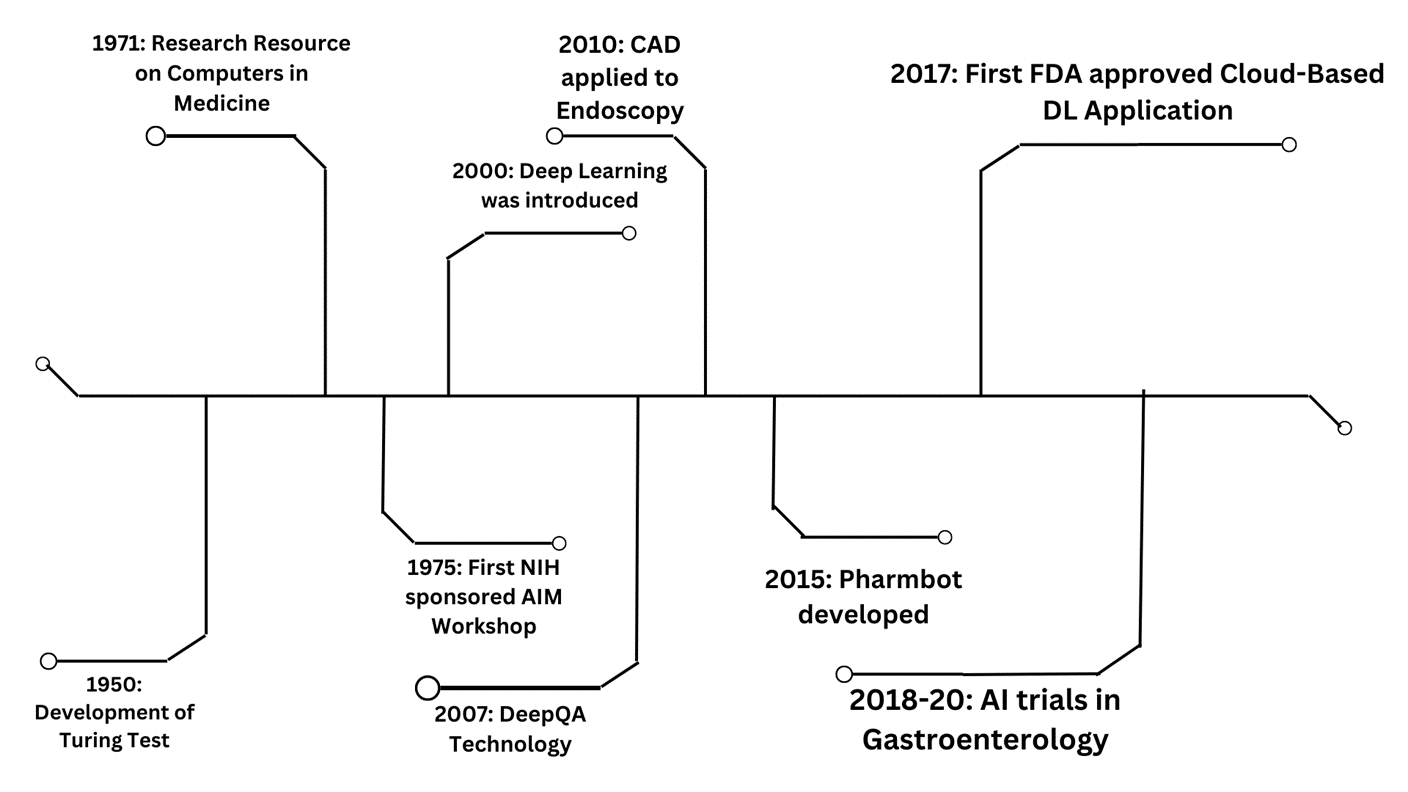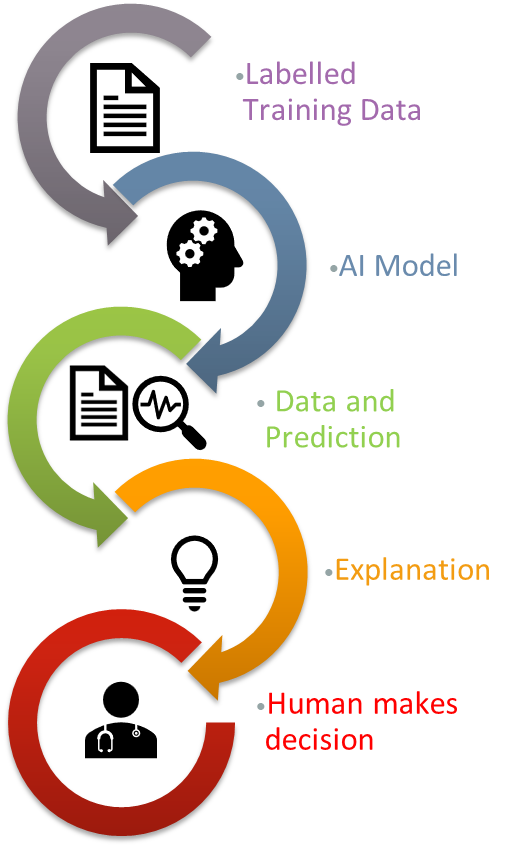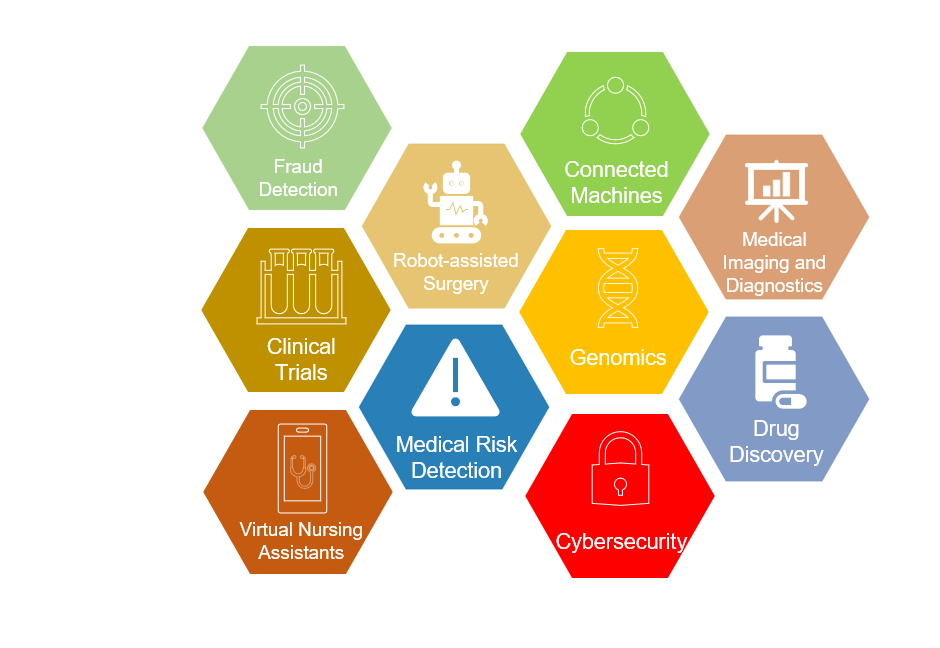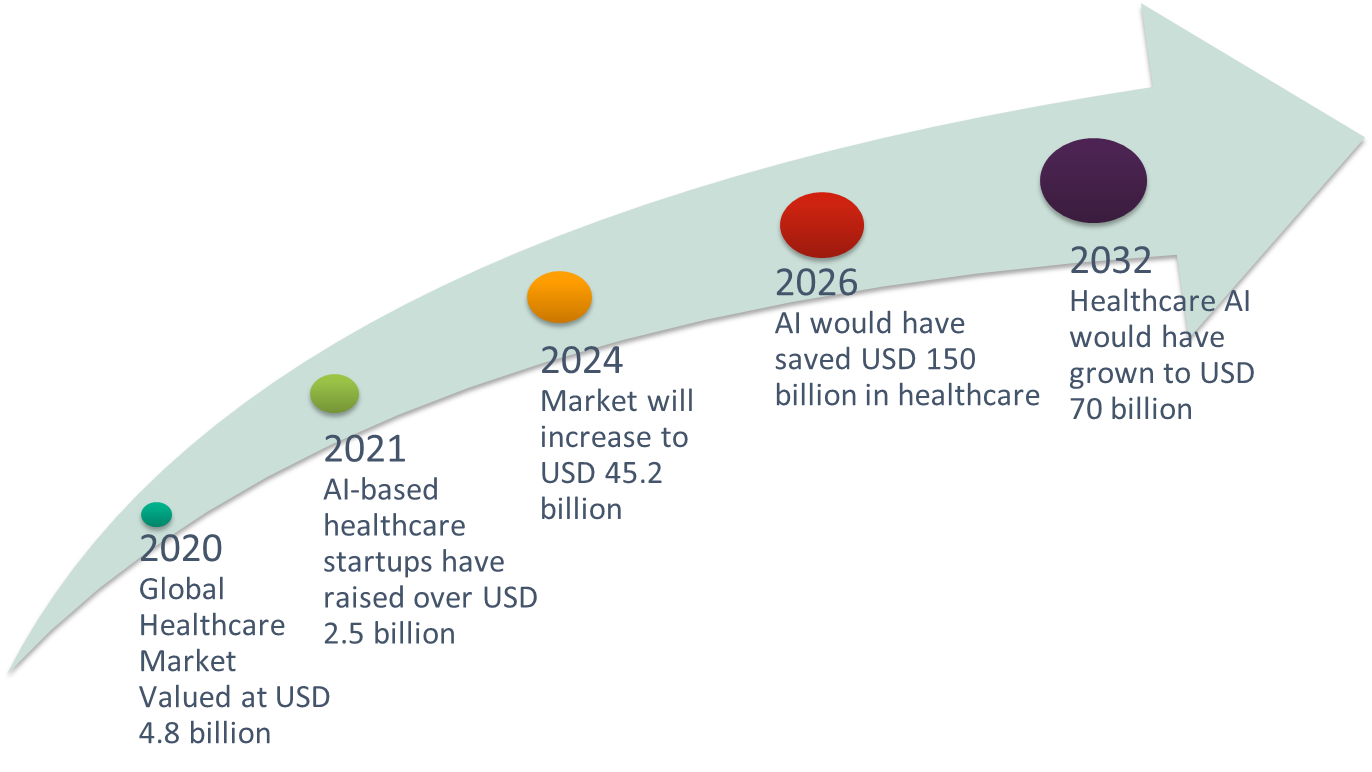Ijraset Journal For Research in Applied Science and Engineering Technology
- Home / Ijraset
- On This Page
- Abstract
- Introduction
- Conclusion
- References
- Copyright
Artificial Intelligence for Healthcare and Diagnostics
Authors: Urvi Desai
DOI Link: https://doi.org/10.22214/ijraset.2024.65065
Certificate: View Certificate
Abstract
AI models are being applied to several components of healthcare including diagnostics, drug development, personalized healthcare plans and so on. The large datasets which rapidly rise in complexity and volume form part of big data, provide the potential for ML models to make significant progress in diagnostics, medical image interpretation and treatment recommendations. The introduction of AI across the various departments of the healthcare industry has already raised efficiency and dropped prices. Covid 19’s exponential growth rate completely overwhelmed the healthcare sector\'s capabilities. AI and robotics became paramount in boosting efforts to detect, identify the risk of and monitor the virus, and develop and deliver the vaccine throughout the planet. The systems that did well generally had large datasets, one modality and did well in testing with foreign data. Currently, low efficiency and high costs make research difficult. With big data being produced at astronomical rates, we should theoretically be making constant discoveries and advancements. However, only part of this data is currently being processed and studied. Attempts are being made to resolve this gap by leveraging AI tools.
Introduction
I. INTRODUCTION
Artificial Intelligence (AI) has immense potential in the healthcare domain. It can be used in patient care, research and development, medical imaging and diagnostics and management. With a lack of resources and medical personnel as compared to the requirement, AI has the capability to make the diagnostic process faster, smoother and more efficient. It also improves the accuracy of outcomes and eliminates human error. AI models are being applied to several components of healthcare including diagnostics, drug development, personalized healthcare plans and so on. AI works by processing and analysing large datasets, finding patterns and producing appropriate outputs. Dealing with such large datasets can be prone to human error and AI is able to do this at a much larger scale than a human can. Thus, academia, public and private sectors are all working on finding ways to implement ML-based diagnostic technologies.
Healthcare organizations have acquired vast datasets of health records, imaging data and this is used by AI to identify various new patterns humans could not process. AI can study images at the pixel level and can thus identify minutes features invisible to the human eye. The company PathAI offers diagnostic systems that eliminate human error and raise accuracy. This system is also capable of using AI-enhanced microscopes to identify bacteria in blood samples with an accuracy of 95%. Thus, AI is being used to save lives using early diagnosis and treatment. Automated tools have now become available in most areas in healthcare including for diagnosis, decision support, genomics and so on. These AI-based systems are quickly becoming as adept as human experts, and are even faster and cheaper. Natural Language Processing (NLP) is being used to acquire data from unstructured text corpora regarding symptoms and medical history of patients for even quicker and error-free diagnosis.

Fig. 1 AI for Healthcare – Application Areas
Fig. 1 shows the various applications of artificial intelligence in 4 broad domains under the healthcare industry, i.e., patient care, medical imaging and diagnosis, research and development and management.
II. LITERATURE SURVEY
Even with the various advances that have been and are being made in medicine, much is left to be done regarding the timely detection and resulting early treatment of diseases. This is further hampered by the lack of continuous health monitoring systems. The paper considers smart wearables that monitor various health parameters as a solution to this problem. It discusses in detail an overview of the features, the advancements made and the future potential of these wearable sensors [1]. The publication discusses the issues posed by the usage of AI in the healthcare industry with respect to ethics and the law. The paper studies recent trends of the same, with emphasis on the United States and Europe. Large datasets are required by any AI model to make accurate predictions and the acquisition and usage of this data raises several questions including those on the informed consent to use it, data privacy and cybersecurity. Models are susceptible to algorithmic bias and the question of liability in case of any mishap arises. Furthermore, the lack of transparency of ML models brings into question the safety, trustworthiness and effectiveness of the system [2].
The paper performs a review and comparative analysis of several papers published between 2009 and 2021 dealing with the application of AI in the diagnosis of cancer. Five investigations were generated and their solutions explored. The deep and machine learning models from the studies were evaluated on several performance metrics like accuracy, precision, recall, area covered, F1-score and so on. The paper concludes that although decent results have been achieved by several techniques applied in the studies, there is a long way to go to actually reduce cancer mortality rates [3]. 288 papers from Scopus were studied concerning AI in healthcare in a structured manner and including a variety of subdomains ranging from clinical decision-making and diagnostics to management and accounting. On analyzing and comparing the papers, it was found that this is still an emerging field. AI can be used to aid medical professionals in diagnosing, predicting the spread of and customizing treatment plans of diseases. The paper concludes that there is still much work to be done for AI-based healthcare to reach close to its potential [4].

Fig. 2 Timeline of AI in Healthcare
Though progress in technology in the healthcare domain has been slower than in most other aspects of our daily lives, the implementation of electronic health records (EHR) in more and more hospitals has increased medical data available. The large datasets which rapidly rise in complexity and volume form part of big data, provide the potential for ML models to make significant progress in diagnostics, medical image interpretation and treatment recommendations. Medicine can thus become faster, more efficient and personalized [5]. Fig. 2 depicts a timeline of the evolution of artificial intelligence in the healthcare industry. Beginning in 1950 with the creation of the Turing Test, the field has come a long way and the same is documented in the above diagram.
III. METHODOLOGY
AI-based systems have proven their utility in analytical tasks, even surpassing human prowess. However, these systems operate with a 'black-box'-like nature, i.e., their internal functioning is not revealed to observers. The resultant lack of explainability of the results makes them questionable in terms of reliability. There are also a host of questions of medicine, law and ethics that get raised. The paper discusses the need and benefits of explainability in AI-based healthcare and its ethical implications in bringing these tools to practical usage [6]. The introduction of AI across the various departments of the healthcare industry has already raised efficiency and dropped prices. Thus, more and more ways to include AI are being pursued, from research and diagnostics to patient care and administration. The paper discusses some areas of improvement for AI to be seamlessly integrated into healthcare, focusing on model interpretability as a gateway to novel biological discoveries. The paper also stresses upon the importance of diverse data types to reduce bias and raise accuracy [7].
In recent years, several advancements have been made in medical technology including the extensive use of AI and robotics. The effectiveness of these technologies must be assessed and the Turing Test invented in 1950 is invaluable in the process even today. This test aims to compare the intelligence of a machine to that of a human. The paper proposes modifications to the test to achieve quantifiable performance evaluation metrics for AI and robotics to be assessed and improved for the best possible outcomes and efficiency [8]. Sixth among the most reported malignant diseases, Oral Cancer (OC) has high mortality rates but is difficult to diagnose until it becomes almost terminal. Low access to advanced diagnostic and imaging systems as well as human specialists worsens the already dire problem. The paper studies the impact of such late-stage detection. It also assesses the AI-driven methods for streamlining and speeding up the process, especially in areas with low availability of resources and experts [9].
Though AI can vastly improve and hasten doctors' work, it has not been implemented much due to no transparency and consequently, trust. The paper discusses how Explainable AI can be used to tackle these issues, goes through some of the latest studies on the same, suggests ways to select appropriate explainable AI methods and enlists numerical performance evaluation metrics.

Fig. 3 The AI Diagnostic Process
It concludes that though explainable AI will theoretically go a long way in the acceptance of AI in mainstream medicine, neither has its utility been proven yet, nor will it be able to solve the issue alone [10]. Fig. 3 shows the process of a diagnostic artificial intelligence system. It takes in labelled training data to learn the diseases and their symptoms, makes a prediction, explains how it got there via symptoms and then allows the human to make the suitable decision.
IV. APPLICATIONS
The paper compiles the findings of papers with the latest developments of AI in healthcare and medical research. It extols the possibilities of implementing AI-based systems in biology and medicine. The paper considers this an emerging field and currently in its infancy, with much to be accomplished still. It also elaborates case studies on epileptic seizure prediction and dysfunctional urinary bladder filling [11]. The absence of transparency and trust in AI-functioning limits its practical applications despite all its merits. To solve this, explainable artificial intelligence or XAI is being used to elaborate how a prediction has been reached. The paper goes through articles from Q1 journals to highlight scope for improvement for XAI. It finds that further research is required into discovering anomalies in one dimensional biosignals and pinpointing the important parts of clinical notes [12].
The paper studies the present scenario of AI-driven healthcare as well as discussing some applications actually in practice. It finds that most major hospitals are boosting their resources using AI tools for diagnosing, treating, nursing and management purposes. The paper enlists both benefits and threats to the field and concludes that though AI will definitely bolster medical efforts, much planning is needed to effectively integrate it into healthcare in practice [13]. Covid 19 is the largest disaster faced by the globe in the memory of most of the living. Its exponential growth rate completely overwhelmed the healthcare sector's capabilities. AI and robotics became paramount in boosting efforts to detect, identify the risk of and monitor the virus, and develop and deliver the vaccine throughout the planet. They also helped placate those struggling mentally and aided in telehealthcare. The paper discusses this usage of AI and robotics to combat the pandemic following the PRISMA method [14].

Fig. 4 Applications of AI in Healthcare
The paper delves into the combination of IoT via cardiac biosensors and ML algorithms for continuous surveillance of heart health. It also discusses the latest advancements made in these sensors with their technical details and use-cases. It also includes suggestions for developing a framework for personalized medicine through interdisciplinary AI projects [15]. Fig. 4 shows some of the use cases of artificial intelligence in the healthcare industry.
From virtual nursing assistants and drug development to fraud detection and clinical trials, ai is now being used in most aspects of the industry.
V. CURRENT STATUS
AI has been transforming most aspects of our lives, including healthcare. The paper studies and finds that several AI systems for cardiology are never practically employed. The systems that did well generally had large datasets, one modality and did well in testing with foreign data. The paper suggests magnifying the approach at the beginning of product development for better results [16]. AI has become popular in medical diagnosis related applications. The paper discusses some of the existing use-cases of AI-based diagnostics to depict its current status to help upcoming research. It also elaborates on the benefits and barriers faced by AI in diagnostics [17].
AI can be used to transform the process of drug discovery. Currently, low efficiency and high costs make research difficult. The paper talks about the major hindrances to, possibilities for improvement and integration of AI into drug development [18]. The paper reviews preliminary research into AI-based healthcare solutions in risk analysis, complications handling, patient care and diagnostics. The paper also discusses some disadvantages of AI in medicine and the attempts being made to overcome them [19].

Fig. 5 Companies working in AI-based Healthcare
The paper discusses how lack of resources and personnel in cancer diagnosis can be overcome by using AI. It elaborates the role of AI in risk evaluation of asymptomatic patients and triaging symptomatic patients. It lists major AI methods in initial-stage detection of cancer. It also lists hindrances including questions of ethics, resource scarcity and privacy [20]. Fig. 5 lists some of the companies that are currently in the industry. These companies have been arranged by their respective subdomains including Imaging and Diagnostics, Predictive Analysis and Risk Scoring, Genomics, Drug Discovery, Virtual Assistant, Hospital Decision Support and Clinical Trials.
VI. FUTURE SCOPE
With big data being produced at astronomical rates, we should theoretically be making constant discoveries and advancements. However, only part of this data is currently being processed and studied. Attempts are being made to resolve this gap by leveraging AI tools. The paper reviews the applications of AI/ML in medicine, focusing on clinical, managerial and international health applications to support the industry at large. It studies the effects, future patterns and possibilities of this technology in the above components of healthcare [21]. With the influx of AI-based technologies entering healthcare, it has become important to consider its legal implications. The paper tries to predict the ways in which AI will work, to find the stakeholders and describe conditions for holding them accountable in case of any legal discrepancy regarding AI. The paper studies sources of judicial governance of AI, focusing on medical norms and standards. It also helps formulate a possible framework for judicial administration of AI in healthcare [22].
With the demand exceeding the supply of radiologists, AI is becoming imperative in building tools to aid in making the diagnostic and medical imaging process faster, smoother and more efficient. The paper reviews a McKinsey and Company work concerning AI in medical imaging, with special emphasis on its use-cases, capital and obstacles.
It also predicts how the industry will grow and concludes that eventually, AI will revolutionize radiology [23]. The potential of AI in pathology is immense and much research is being done to realize this potential to perform analytical tasks in a formal, quantitative manner. Apart from imaging, the paper studies the possible scope of AI to be used on a molecular level. The paper claims AI will not replace pathologists, but rather boost their efforts. It finds from its reviews that though AI is now extensively being used in the diagnosis of cancer and other ailments, it still cannot capture the complexity a human expert is capable of [24].

Fig. 6 Predicted Valuation of AI-based Healthcare
The paper contains reviews by two surveyors of publications on AI in healthcare to predict the future scope of the field. The study finds that AI can be implemented in disease detection, treatment, reducing costs and promoting medical equity. The paper also enlists some ethical risks posed by mainstream adaptation of AI, including patient data privacy [25]. The Figure 6 depicts some of the current and estimated progress made by AI in the healthcare industry. A whopping 45% growth is estimated between 2021-27 alone.
Conclusion
Artificial Intelligence (AI) has immense potential in the healthcare domain. AI can be used to aid medical professionals in diagnosing, predicting the spread of and customizing treatment plans of diseases. More and more ways to include AI are being pursued, from research and diagnostics to patient care and administration. The absence of transparency and trust in AI-functioning limits its practical applications despite all its merits. To solve this, explainable artificial intelligence or XAI is being used to elaborate how a prediction has been reached. AI can be used to transform the process of drug discovery. With the demand exceeding the supply of radiologists, AI is becoming imperative in building tools to aid in making the diagnostic and medical imaging process faster, smoother and more efficient.
References
[1] Y. N. R. Z. T. J. W. H. Zheng, “Smart Materials Enabled with Artificial Intelligence for Healthcare Wearables,” Adv. Funct. Mater., vol. 31, p. 2105482, 2021. [2] T. M. G. C. Sara Gerke, “Ethical and legal challenges of artificial intelligence-driven healthcare,” in Artificial Intelligence in Healthcare, Academic Press, 2020, pp. 295-336. [3] Y. G. S. S. R. Kumar, “A Systematic Review of Artificial Intelligence Techniques in Cancer Prediction and Diagnosis,” Arch Computat Methods Eng, vol. 29, p. 2043–2070, 2022. [4] S. C. D. S. A. Secinaro, “The role of artificial intelligence in healthcare: a structured literature review,” BMC Med Inform Decis Mak, vol. 21, p. 125, 2021. [5] S. S. E. Dilsizian, “Artificial Intelligence in Medicine and Cardiac Imaging: Harnessing Big Data and Advanced Computing to Provide Personalized Medical Diagnosis and Treatment,” Curr Cardiol Rep, vol. 16, p. 441, 2014. [6] J. B. A. V. E. Amann, “Explainability for artificial intelligence in healthcare: a multidisciplinary perspective,” BMC Med Inform Decis Mak, vol. 20, p. 310, 2020. [7] N. M. J. E. O. E. Coryandar Gilvary, “The Missing Pieces of Artificial Intelligence in Medicine,” Trends in Pharmacological Sciences, vol. 40, no. 8, pp. 555-564, 2019. [8] H. D. A. a. A. T. Ashrafian, “A novel modification of the Turing test for artificial intelligence and robotics in healthcare,” Int J Med Robotics Comput Assist Surg, vol. 11, p. 38– 43, 2015. [9] P. G. P. W.-S. Betul Ilhan, “The contribution of artificial intelligence to reducing the diagnostic delay in oral cancer,” Oral Oncology, vol. 116, pp. 1368-8375, 2021. [10] J. A. K. P. R. R. Aniek F. Markus, “The role of explainability in creating trustworthy artificial intelligence for health care: A comprehensive survey of the terminology, design choices, and evaluation strategies,” Journal of Biomedical Informatics, vol. 113, pp. 1532-0464, 2021. [11] A. M. E. B. A. B. Z. M. S. Guoguang Rong, “Artificial Intelligence in Healthcare: Review and Prediction Case Studies,” Engineering, vol. 6, no. 3, pp. 291-301, 2020. [12] C. P. O. S. S. P. D. B. F. M. U. R. A. Hui Wen Loh, “Application of explainable artificial intelligence for healthcare: A systematic review of the last decade (2011–2022),” Computer Methods and Programs in Biomedicine, vol. 226, pp. 0169-2607, 2022. [13] D. Lee and S. Yoon, “Application of Artificial Intelligence-Based Technologies in the Healthcare Industry: Opportunities and Challenges,” International Journal of Environmental Research and Public Health, vol. 18, no. 1, p. 271, 2021. [14] L. J. S. F. A. N. I. Sujan Sarker, “Robotics and artificial intelligence in healthcare during COVID-19 pandemic: A systematic review,” Robotics and Autonomous Systems, vol. 146, pp. 0921-8890, 2021. [15] R. D. A. K. A. Vashistha, “Futuristic biosensors for cardiac health care: an artificial intelligence approach,” 3 Biotech, vol. 8, p. 358, 2018. [16] J. v. d. E. S. K. H. J. R. Cedric Manlhiot, “A Primer on the Present State and Future Prospects for Machine Learning and Artificial Intelligence Applications in Cardiology,” Canadian Journal of Cardiology, vol. 38, no. 2, pp. 169-184, 2022. [17] M. S. S. &. F. N. Mirbabaie, “Artificial intelligence in disease diagnostics: A critical review and classification on the current state of research guiding future direction,” Health Technol, vol. 11, pp. 693-731, 2021. [18] M. R. P. Kit-Kay Mak, “Artificial intelligence in drug development: present status and future prospects,” Drug Discovery Today, vol. 24, no. 3, pp. 773-780, 2019. [19] A. Becker, “Artificial intelligence in medicine: What is it doing for us today?,” Health Policy and Technology, vol. 8, no. 2, pp. 198-205, 2019. [20] B. S. H. a. R. W. L. Hunter, “The Role of Artificial Intelligence in Early Cancer Diagnosis,” Cancers, vol. 14, no. 6, p. 1524, 2022. [21] K. P. D. D. U. M.-L. M. V. Kumar K, “Artificial Intelligence and Machine Learning Based Intervention in Medical Infrastructure: A Review and Future Trends,” Healthcare, vol. 11, no. 2, p. 207, 2023. [22] E. I. F. D. Laptev VA, “Medical Applications of Artificial Intelligence (Legal Aspects and Future Prospects) ,” Laws, vol. 11, no. 1, p. 3, 2022. [23] A. J. C. F. D. Z. Alan Alexander, “An Intelligent Future for Medical Imaging: A Market Outlook on Artificial Intelligence for Medical Imaging,” Journal of the American College of Radiology, vol. 17, pp. 165-170, 2020. [24] M. A. M. A. P. J. M. B. J. B. J. L. J. E. D. K. P. S. A. H. W. F. T. D. C. K.-R. M. F. K. Albrecht Stenzinger, “Artificial intelligence and pathology: From principles to practice and future applications in histomorphology and molecular profiling,” Seminars in Cancer Biology, vol. 84, pp. 129-143, 2022. [25] F. F. R. M. N. M. R. K. F. R. M. Sri Sunarti, “Artificial intelligence in healthcare: opportunities and risk for future,” Gaceta Sanitaria, vol. 35, no. 1, pp. S67-S70, 2021.
Copyright
Copyright © 2024 Urvi Desai. This is an open access article distributed under the Creative Commons Attribution License, which permits unrestricted use, distribution, and reproduction in any medium, provided the original work is properly cited.

Download Paper
Paper Id : IJRASET65065
Publish Date : 2024-11-07
ISSN : 2321-9653
Publisher Name : IJRASET
DOI Link : Click Here
 Submit Paper Online
Submit Paper Online

